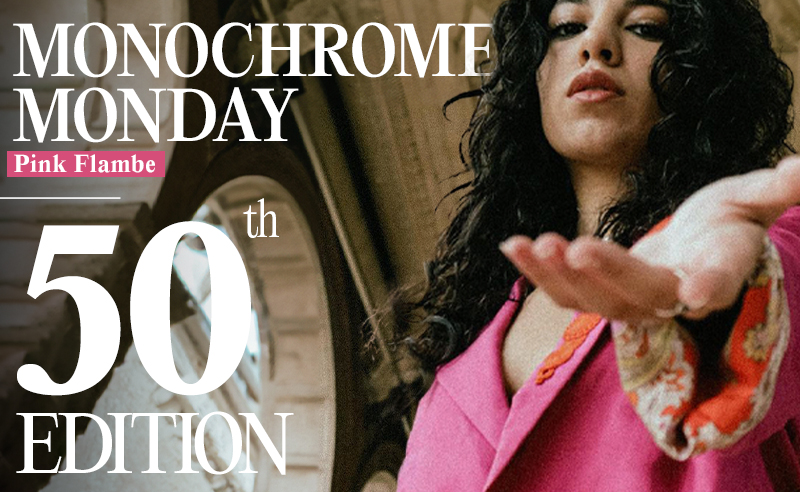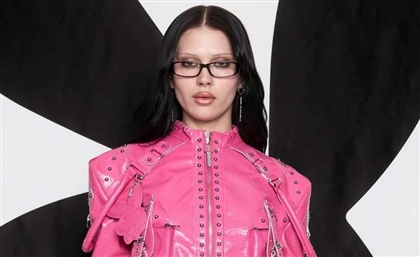The 50th Edition of Monochrome Monday: Pink Flambe
It’s the 50th edition of Monochrome Monday, and we’re celebrating with an intensive look at one of the most significant colours of the decade.

A Brief History of Pink in Fashion
Pink in fashion hasn't always enjoyed its current popularity, especially vibrant, 'girly' hues like Pink Flambe. Its journey through the fashion spectrum is surprisingly complex, intertwined with societal expectations and ingrained gender stereotypes. While the exact origin of the term 'pink' is debated, its usage can be traced back to the 17th century. Interestingly, for much of history, pink wasn't solely associated with femininity. In the 18th century, both men and women wore the colour, often signifying wealth and status due to the rarity and expense of producing pink dyes.
 Geyanna Younes x Messika | Fuchsia Feather Gown
Geyanna Younes x Messika | Fuchsia Feather Gown
 Nadia Kadi | Pink Imperial Pumps
Nadia Kadi | Pink Imperial Pumps
The Shift to the 'Girl's Colour'
The 20th century witnessed a dramatic shift. By the mid-1900s, a more rigid association of pink with girls and femininity had taken root. This trend likely stemmed from a combination of factors: the rise of mass-produced clothing targeted towards specific genders, and the growing influence of marketing and advertising strategies that relied heavily on gendered colour coding to sell products.
 Therinos Resort Wear | Lily Bikini in Fuchsia
Therinos Resort Wear | Lily Bikini in Fuchsia
 Nafsika Skourti | Mini Fox Dress
Nafsika Skourti | Mini Fox Dress
The 'Too Girly' Stigma
The latter half of the 20th century saw pink firmly entrenched as the 'girl's colour'. Unfortunately, this association often carried negative connotations, where pink became synonymous with childishness, fragility, and a lack of seriousness. This perception not only restricted colour choices for girls but also potentially limited the way they were perceived in professional settings. During that era, Google searches saw many hits for "is it OK to wear pink at work?" and "how to wear pink in the office and still remain professional?"
For decades, professional women who chose pink attire faced unfair scrutiny, highlighting the persistent gender bias embedded in colour associations. Studies have demonstrated that unconscious gender bias can impact hiring decisions, performance evaluations, and opportunities for career advancement (Smith & Johnson, 2018).
 Meera Toukan | Signature Hob Clutch
Meera Toukan | Signature Hob Clutch
Breaking the Mould
The tide began to turn in the late 20th and early 21st centuries, as fashion embraced a more fluid approach to gender expression. Designers like Elsa Schiaparelli and Rei Kawakubo challenged traditional notions of masculinity and femininity through their use of pink. This shift was further bolstered by pop culture icons like David Bowie and Prince, who adopted the colour as a symbol of rebellion and individuality, and movements like the 1960s Pop Art movement, as seen in Andy Warhol’s interpretation of Marilyn Monroe.
 Onori the Label | Puff Sleeves
Onori the Label | Puff Sleeves
 Lune de Jour | Blazer Boyfriend
Lune de Jour | Blazer Boyfriend
Pink Today: A Spectrum of Expression
Today, pink occupies a much more nuanced position in fashion. The colour's spectrum expands beyond the 'girly' stereotype, finding a place in everything from architecture to activism. Recent movements, like the pink "pussyhats" of anti-Trump marches, CodePink's anti-war protests, and the Gulabi Gang in India, showcase how pink is being utilized in political activism, especially for women's rights and healthcare.
Men and women alike are embracing pink in its various forms, reclaiming it as a colour. This trend was partially influenced by the 2023 movie 'Barbie,' where cinema-goers wore full-on pink outfits in a celebration of womanhood. Pink Flambe has been spotlighted in recent runway shows, such as Valentino’s SS '24 men’s collection and Elie Saab’s SS’24 women’s collection.
 Kaltham’s Fine Jewellery | Studs
Kaltham’s Fine Jewellery | Studs
American artist and photographer Signe Pierce posed a thought-provoking question in a 2017 interview (Bucknell, 2017): “How often do you see pink in architecture or machinery? How often is pink presented outside of a gendered perspective?” Pierce argues that this societal conditioning, pushing women to identify with a colour not often present in the "real world," is a subtle but powerful tool that reinforces patriarchal structures and keeps women confined to traditional, submissive roles in everyday life.
Sources:
Smith, J., & Johnson, L. (2018). Gender Bias in the Workplace: An Examination of Gender Stereotyping and its Impact on Women’s Career Advancement. Journal of Management and Marketing Research, 22, 1–14.
Bucknell, A. (2017). A Brief History of the Colour Pink. Artsy.
- Previous Article British JD Sports Makes Its Egyptian Debut at Cairo Festival City Mall
- Next Article Monochrome Monday: The Electric Blue Edition
Trending This Month
-
Nov 08, 2025
















